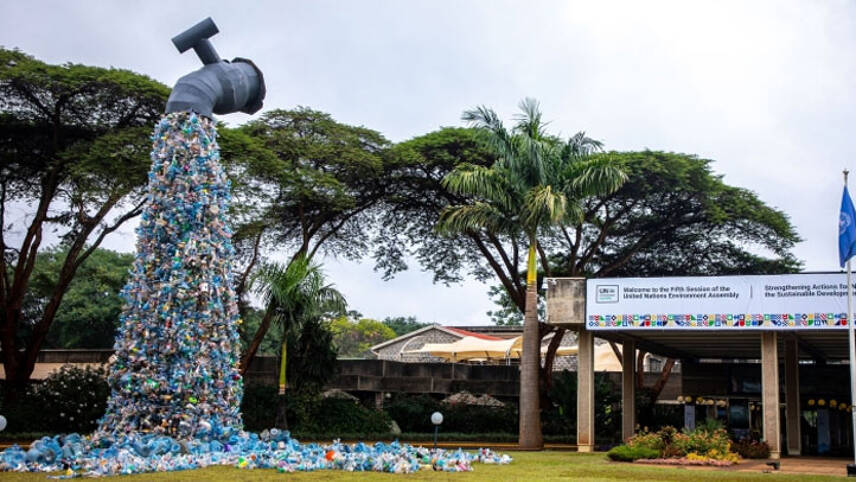This premium content is exclusive to edie Members.
To find out more about edie Membership, please click below.
If you are an existing member, login here

Image: UNEP
Around 21 million tonnes of plastics leaked into the environment last year, according to the OECD. Almost half of this entered aquatic environments.
The body estimates that, in a business-as-usual scenario, macrooplastic pollution would increase by 50% by 2040. Systemiq anticipates a steeper uptick exceeding 100% when microplastics are also accounted for.
In a bid to tackle the issue, the UN Environment Programme (UNEP) is coordinating a new global Plastics Treaty which it hopes to have ratified in 2024. 169 nations are involved in the Treaty’s development.
Following two initial rounds of talks last year and earlier in 2023, the so-called INC-3 meetings are taking place at the UNEP’s headquarters in Nairobi this week, from 13 to 17 November – and signs of the likely tensions and sticking points in negotiations are already emerging.
Discussions will further shape the forthcoming Treaty following the release of a first draft this September. The UNEP has described the Treaty as having the potential to be the most important multilateral agreement on the environment since the Paris Agreement was ratified in 2015, but there are many details still to be agreed upon.
A key sticking point at present is how the Treaty will reduce the production of virgin plastics in the first instance. Nations agreed last year that the agreement should cover all parts of the lifecycle including production, despite protests from some nations with large petrochemical sectors.
The INC 2 talks did not result in an agreement on how limiting plastic production should be orchestrated. Three options are now on the table: a global target for reduction applied to all nations; a global target with nationally determined contributions; or leaving targets up to individual nations.
The US had been a strong advocate for the latter approach along with the likes of China, India and Saudia Arabia.
This rhetoric is likely to intensify at INC 3. Russia, China, Saudi Arabia, Cuba and Bahrain have formed a new coalition called the Global Coalition for Plastics Sustainability, in a move that the Environmental Investigation Agency (EIA) called “highly concerning”.
EIA campaigner Jacob Kean-Hammerson said: “Prominent plastic producing countries have formed a ‘Coalition of the Unwilling’ and are coordinating efforts to prevent progress by pushing focus on preventing controls on production. We cannot afford to waste any more time, and ambitious countries must take the charge in shutting down these attempts to weaken the Treaty”.
There is a larger High Ambition Coalition of countries advocating for the Treaty to include “control measures that will minimise the demand of plastics”. More than 60 nations are participants including the UK, Germany, Australia and France. The Coalition reiterated its call to action ahead of INC 3.
Corporate disclosures
With all of this in mind, we can expect explosive debates on the issue of plastic production.
Another key detail yet to be agreed upon is whether the Treaty will encourage or require national governments to mandate plastic-related disclosures from large businesses. This is still on the table and would, if adopted, mirror the nature-related corporate disclosure agreements included in the Biodiversity Treaty ratified last December.
Dozens of financial institutions managing more than $3.5trn of assets collectively are advocating for the Treaty to require disclosure mandates covering plastic dependencies, related risks, and opportunities across the whole lifecycle.
This data would give investors a better picture of plastic-related risks which many NGOs believe are currently underestimated.
This call to action is coordinated by CDP, which has succeeded in getting more than 3,000 businesses to disclose on plastics on a voluntary basis.
Is it possible to achieve a world without plastic pollution?
The OECD has this month published a new report setting out how effective different combinations of policy interventions could be at eliminating plastic pollution globally by 2040. All scenarios span through to 2060.
In its most ambitious and wide-ranging scenario, 115 million metric tonnes of mismanaged plastics waste are avoided in 2040. This is equivalent to more than 95% of the total plastics waste that was produced last year.
Plastic leaking into the environment would almost be eliminated and the lifecycle emissions associated with plastics would drop by more than 40%.
This scenario involves capping primary plastics use below 2020 levels; quadrupling global plastics recycling rates and scaling investment in other solutions to halt plastic leakage into the environment, particularly in developing and emerging markets.
Crucially, policy interventions are needed at the design stage. Governments would intervene to phase down and out the production of products and packaging that cannot be recycled and would also ban some of the most unnecessary and polluting plastics. Microplastics added to products are one of the focus areas here.
Regarding international investments in waste management, wealthy nations would need to play their part in leveraging an additional $1trn of investment in non-OECD nations over a 20-year period. This funding need not all come from public sources; effective mechanisms for unlocking private finance should also be identified and used. Efforts will, importantly, need to be focused also on evening out how finance is distributed.
The OECD report emphasises that less ambitious and coordinated action will ultimately result in lower decreases in plastic pollution and the sector’s emissions, potentially for a higher upfront cost. These approaches would also go less far in terms of reducing externalised costs of plastics such as human health impacts.
This echoes findings published by the UNEP in May. The body set out a policy scenario in which global plastic pollution rates are reduced by more than 80% by 2040, with more than $4.5trn of cost savings reaped in the process.
Both the UNEP and OECD scenarios rely mainly on technologies that already exist. What would be unprecedented, however, is the level of global focus and coordination.


Please login or Register to leave a comment.